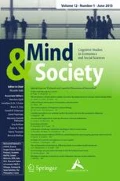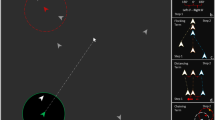Abstract
In this paper, we describe a framework for studying social agents’ individual decision making, that takes account of the environment and social dynamics. We describe a study in which we explored the efficiency of foraging strategies within a group of individuals faced with a resource-limited environment. We investigated to what extent cooperative and non-cooperative behaviors impacted on the survival rates of a population of individuals. In the experiment presented here, we considered two different types of individuals: selfish individuals who gather energy for their own use, and cooperative individuals who share the energy they gather with others, thus reducing their own individual chances of survival. In order to study the trade-off between non-cooperative and cooperative behaviors in a pseudo-realistic two-dimensional environment, we introduced an agent-based modeling and simulation tool called ACACIA-ES, which simulated local interactions and spatial behavior for large numbers of individuals in complex environments. The main result from our simulation was that a group of cooperative individuals displayed better survival strategies than groups of selfish individuals when faced with a variety of environmental pressures; however, it was very unlikely that such cooperative strategies could resist competition from selfish individuals, if the outcome of past social interactions was memorized, even when a very small group of selfish individuals was introduced.


Similar content being viewed by others
Notes
The Gspeed parameter determines resource regrowth according to the following equation: \( {\text{t}}\;\bmod (2 \times 2^{{(6 - {\text{Gspeed}})}} ) = 0, \) in such a way that if a user chooses 2 for the Gspeed parameter, trees will be generated every 32 steps with nf fruits on a randomly chosen free patch within the environment.
An agent's initial energy level is initialized at half the maximal energy it can recharge (\( \varepsilon_{\hbox{max} } \)), where \( \varepsilon_{\hbox{max} } = 200 \) that is: \( \varepsilon_{{{\text{t}} = 0}} \left( {a_{i} } \right) = \frac{1}{2}\varepsilon_{\hbox{max} } = 100. \) This initial energy level for each agent is thus initialized at 100 to allow it to make a tour of the environment perimeter at least once. The energy level \( \varepsilon_{t} (a_{i} ) \) for an agent a i at a time t decreases by one with each step. If the energy level falls to zero, the agent perishes and disappears.
An agent using a “tit-for-tat” (TFT) behavior will initially cooperate, then will respond in the same way that the other agent responded to him.
Preliminary calibration experiments showed this number of replications to provide the best trade-off between statistical relevance and computational cost (not shown here).
For 30 trials in which energy was either shared or not shared, at least 15 % of the population died of starvation after 1000 simulation steps.
Since the possibility of the agents moving obviously depended on the number of obstacles occupying the environment, based on previous results (Zibetti et al. 2007; Salvador et al. 2009), we increased the percentage of vital space slightly (about 84 % of the cells were free) and decreased it slightly (about 89 % of the cells were free). Changes in the percentage of vital space produced respectively a slight increase and a slight decrease in the final agent survival rate in both agent populations but no significant differences were observed between the cooperative and selfish populations after 2000 simulation steps and 200 repetitions.
After 2000 simulation steps, we observed a stabilization in the surviving population and the differences remained static.
For instance, in an ecosystem that was highly limited in terms of available resources (nf = 5 and Gspeed = 3), as well as in a more abundant one (nf = 17 and Gspeed = 5), the reduction in percentage of vital space (from 87 to 84 % free cells) led to a global decrease and increase in agent survivability after 2000 simulation steps in both cooperative and selfish populations respectively, regardless of vital space percentage (MA = 6.57, SDA 2.01; MS = 6.39, SDS 1.80 and MA = 77.36, SDA 5.43; MS = 68.21, SDS 4.94 respectively). These results are comparable to those obtained with the same resource configuration and 87 % free space (Table 2).
References
Alvard MS, Nolin DA (2002) Rousseau’s Whale Hunt? Coordination among Big Game Hunters. Curr Anthropol 43(4):533–559
Axelrod R (1984) The evolution of cooperation. Basic Books, New York
Axelrod R (2001) The complexity of cooperation: agent-based models of competition and collaboration. Princeton University Press, Princeton
Axelrod R, Dion D (1988) The further evolution of cooperation. Science 242:1385–1390
Axelrod R, Hamilton WD (1981) The evolution of cooperation. Science 211(4489):1390–1396
Binmore K, Castelfranchi C, Doran J, Wooldridge M (1998) Rationality in multi-agent systems. Knowl Eng Rev 13:309–314
Bousquet F, Le Page C (2004) Multi-agent simulations and ecosystem management: a review. Ecol Model 176:313–332
Bravo G (2008) Imitation and cooperation in different helping games. J Artif Soc Soc Simul 11(1):8
Camerer CF (2004) Prospect theory in the wild: evidence from the field. In: Camerer CF, Loewenstein G, Rabin M (eds) Advances in behavioral economics. Princeton University Press, Princeton, pp 148–161
Castelfranchi C, Rosis FD, Falcone R, Pizzutilo S (1998) Personality traits and social attitudes in multiagent cooperation. Appl Artif Intell 12(7–8):649–675
Cecconi F, Parisi D (1998) Individual versus social survival strategies. J Artif Soc Soc Simul 1(2):1–17
Chen SH (2012) Varieties of agents in agent-based computational economics: a historical and an interdisciplinary perspective. J Econ Dyn Control 36(1):1–25
Costopoulos C (2001) Evaluating the impact of increasing memory on agent behaviour: adaptive patterns in an agent based simulation of subsistence. J Artif Soc Soc Simul 4(4). http://jasss.soc.surrey.ac.uk/4/4/7.html
Durlauf SN, Young-Peyton H (eds) (2001) Social dynamics, vol 4. MIT Press, Cambridge, MA
Epstein JM, Axtell R (1996) Growing artificial societies: social science from the bottom up. Brookings Institution Press, Washington
Fehr E, Fischbacher U (2003) The nature of human altruism. Nature 425(6960), 785–791. http://doi.org/10.1038/nature02043
Grimm V, Railsback SF (2005) Individual-based modeling and ecology. Princeton University Press, Princeton
Gui B, Sudgen R (eds) (2005) Economics and social interaction. Accounting for interpersonal relations. Cambridge University Press, Cambridge
Hamilton WD (1963) The evolution of altruistic behavior. Am Nat 97(896):354–356
Hardin G (1968) The tragedy of the commons. Science 162(3859):1243–1248
Hauzy C, Tully T, Spataro T, Paul G, Arditi R (2010) Spatial heterogeneity and functional response: an experiment in microcosms varying obstacle densities. Oecologia 163:625–636
Hirshleifer J (1987) Disaster behaviour: altruism or alliance? In: Economic behaviour in adversity. The University of Chicago press, pp 134–141. http://press.uchicago.edu/ucp/books/book/chicago/E/bo3642293.html
Jaffe K (2002) An economic analysis of altruism: who benefits from altruistic acts? J Artif Soc Soc Simul 5(3). http://jasss.soc.surrey.ac.uk/5/3/3.html
King AW, With KA (2002) Dispersal success on spatially structured landscapes: when do spatial pattern and dispersal behavior really matter? Ecol Model 147(1):23–39
Klecka J, Boukal DS (2014) The effect of habitat structure on prey mortality depends on predator and prey microhabitat use. Oecologia 176(1):183–191
Le Galliard JF, Ferriére R, Dieckmann U (2003) The adaptive dynamics of altruism in spatially heterogenous populations. Evolution 57:1–17
LeBaron B, Tesfatsion L (2008) Modeling macroeconomies as open-ended dynamic systems of interacting agents. Am Econ Rev 98(2):246–250
Lehmann L, Keller L (2006) The evolution of cooperation and altruism—a general framework and a classification of models. J Evol Biol 19(5):1365–1376
Lytinen SL, Railsback SF (2012). The evolution of agent-based simulation platforms: a review of netlogo 5.0 and relogo. In: Proceedings of the fourth international symposium on agent-based modeling and simulation
Mayhew PJ (2006) Discovering evolutionary ecology: bringing together ecology and evolution. Oxford University Press, Oxford
Maynard-Smith J (1982) Evolution and the theory of games. Cambridge University Press, Cambridge
Nash John (1950) Equilibrium points in n-person games. Proc Natl Acad Sci USA 36(1):48–49
Requejo RJ, Camacho J (2011) Evolution of cooperation mediated by limiting resources: connecting resource based models and evolutionary game theory. J Theor Biol 272(1):35–41
Roberts ME, Goldstone RL (2006) EPICURE: spatial and knowledge limitations in group foraging. Adapt Behav 14(4):291–313
Salvador F, Quera V, Zibetti E, Tijus C, Miñano M (2009) ACACIA: an agent-based program for simulating adaptive behavior to reach long-term goals. Cogn Process 10:95–99
Schultz WP, Shriver C, Tanbanico JJ, Khazian AM (2004) Implicit connections with nature. J Environ Psychol 24:31–42
Smith JE, Swanson EM, Reed D, Holekamp KE (2012). Evolution of cooperation among mammalian carnivores and its relevance to hominin evolution. Curr Anthropol 53(S6):S436–S452. http://doi.org/10.1086/667653
Tesfatsion L (2006) Agent-based computational economics: a constructive approach to economic theory. Handb Comput Econ 2:831–880
Trivers RL (1971) The evolution of reciprocal altruism. Q Rev Biol 46(1):35–57
Vazirani VV, Nisan N, Roughgarden T, Tardos É (2007) Algorithmic game theory (PDF). Cambridge University Press, Cambridge. ISBN 0-521-87282-0
Voelkl B, Kasper C (2009) Social structure of primate interaction networks facilitates the emergence of cooperation. Biol Lett 5:462–464
von Neumann J, Morgenstern O (1944) Theory of games and economic behavior. Princeton University Press, Princeton
West Stuart A, Griffin Ashleigh S, Gardner Andy (2007) Social semantics: altruism, cooperation, mutualism, strong reciprocity and group selection. J Evol Biol 20(2):415–432
Whiten A (2000) Primate culture and social learning. Cogn Sci 24(3):477–508
Witkowski M (2007) Energy sharing for swarms modeled on the common vampire bat. Adapt Behav 15(3):307
Younger SM (2003) Discrete agent simulations of the effect of simple social structures on the benefits of resource sharing. J Artif Soc Soc Simul 6(3). http://jasss.soc.surrey.ac.uk/6/3/1.html
Zambonelli F, Jennings NR, Wooldridge M (2001) Organisational rules as an abstraction for the analysis and design of multi-agent systems. Int J Softw Eng Knowl Eng 11(03):303–328
Zentall TR, Galef BG Jr (2013) Social learning: psychological and biological perspectives. Psychology Press, New York
Zibetti E, Quera V, Tijus CA, Beltran F (2002) Reasoning based on categorization for interpreting and acting: a first approach. Mind Soc 14:89–106
Zibetti E, Tijus C, Quera V, Beltran FS, Bui M, Pham M (2007) ACACIA-cooperation: emergent strategies in an evolutionary multi-agents system under environmental constraints. In: Addendum contributions to the 5th international conferences on research, innovation & vision for the future (RIVF’07). IEEE Computer Society Press, Hanoï, Vietnam, pp 19–25
Acknowledgments
We thank Vicenç Quera for helpful discussions for the improving of the computational model. Rob Pratt and Mark Jayes for their help in proofreading. We also thank the two anonymous referees for their useful comments.
Author information
Authors and Affiliations
Corresponding author
Rights and permissions
About this article
Cite this article
Zibetti, E., Carrignon, S. & Bredeche, N. ACACIA-ES: an agent-based modeling and simulation tool for investigating social behaviors in resource-limited two-dimensional environments. Mind Soc 15, 83–104 (2016). https://doi.org/10.1007/s11299-015-0173-0
Received:
Accepted:
Published:
Issue Date:
DOI: https://doi.org/10.1007/s11299-015-0173-0




